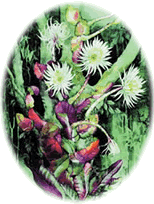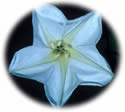Concepts

Margaret Mee (1909-1988) was a botanical artist who often traveled up the Amazon River alone in search of rare flowers to collect and paint. Even at the age of 79, she planned to return to the Amazon for another excursion. On Thanksgiving Day in 1988, Ms. Mee was interviewed on the MacNeil-Lehrer NewsHour; she fascinated the television audience with her accounts of her travels. Tragically, she was killed in an auto accident less than a week later. Even after her death, however, she is still having a profound impact on the preservation of rare flowers in the rainforests. In this lesson, you will learn how Mee’s activities are helping markets save the rare moonflower.
Introduction

Margaret Mee (1909-1988) was a botanical artist who often traveled up the Amazon River alone in search of rare flowers to collect and paint. Even at the age of 79, she planned to return to the Amazon for another excursion. On Thanksgiving Day in 1988, Ms. Mee was interviewed on the MacNeil-Lehrer NewsHour; she fascinated the television audience with her accounts of her travels. Tragically, she was killed in an auto accident less than a week later. Even after her death, however, she is still having a profound impact on the preservation of rare flowers in the rain forests. In this lesson, you will learn how Mee's activities are helping markets save the rare moonflower.
(image courtesy of Margaret Mee's Amazon by Antique Collector's Club)
Learning Objectives
- Describe how markets can be used to preserve rare flora and fauna.
- Given a resource, identify its alternative uses.
Resource List
-
Bolivia: This website provides information on the country of the Republic of Bolivia.
www.virtualsources.com/Countries/Latin%20America%20Countries/Bolivia.htm
-
Bolivian Deforestation from 1984-2000: Using Landsat images of Bolivia taken in 1984 and 2000, this website demonstrates the dramatic deforestation of the Bolivian forest.
https://svs.gsfc.nasa.gov/vis/a000000/a002000/a002096/index.html
-
Hunt Institute for Botanical Documentation: At this site, transcript of Margaret Mee's final interview can be found.
huntbotanical.org/art/show.php?6
-
Amazon Boat Trip Article: This site is marketing a trip to retrace Mee's river routes and is used in the third activity of this lesson.
www.preview2.econedlink.org/lessons/docs_lessons/127_amazon1.pdf
Process
Activity 1
Go to the Hunt Institute for Botanical Documentation for a complete transcript of Margaret Mee's final interview.
Answer these questions based upon the interview above:
-
Ms. Mee is best known for her paintings. Besides creating beautiful images for people to enjoy, what purpose did her activity serve? [Ms. Bee created a unique record of rare species of flowers in the Amazon River basin.]
-
What was the urgency behind her work? [Her work was urgent because the encroachment of man threatened the existence of rare species of flora.]
-
According to Mee, what percent of the Atlantic Forest remains today? [Less than 5% of the Atlantic Forest remains today according to Mee.]
-
Describe some of the rare flowers that attracted Mee to the rainforest. [The answers will vary.]
-
What flower did Mee seek in the spring before her death? [Mee was seeking the moonflower.]
-
What was special about that flower? [That flower was special because it only opened at night when there was a full moon.]
-
What did she fear more than poisonous insects and snakes? Do you agree? Why or why not? [She feared semi-civilized humans more than poisonous insects and snakes. The answers will vary.]
- What did Mee expect to see on her next visit? [Mee expected to see more deforestation.]
Activity 2
View https://svs.gsfc.nasa.gov/vis/a000000/a002000/a002096/index.html of deforestation around Santa Cruz, Bolivia.
 Make general observations about the satellite images of the region for 1984 and 1998. The forests are indicated by green regions; deforested areas are indicated by reddish-brown areas. [NOTE: It is not necessary to click on the links to the other image files or the Quicktime movie. They take a long time to download.]
Make general observations about the satellite images of the region for 1984 and 1998. The forests are indicated by green regions; deforested areas are indicated by reddish-brown areas. [NOTE: It is not necessary to click on the links to the other image files or the Quicktime movie. They take a long time to download.]
-
What activities are leading to deforestation in the depicted region? [Soybean farming among Mennonites and Japanese are leading to deforestation in the depicted region.]
-
Why do you suppose this land is being changed from its natural condition in favor of alternative uses? [The alternative uses provide a higher return to the landowner.The landowner earns more income raising soybeans than he or she could earn using the land as a nature preserve.]
-
Make a list of ten possible uses (products) of this land. HINT: Scroll down to review the "Economy" section to see the products exported from Bolivia.
[Soybeans, cotton, potatoes, corn, sugarcane, rice, wheat, coffee, beef, barley, and quinine]
-
How many of these ten products pass through markets (i.e. can be purchased)? [The answers will vary.]
- Many products from the environment (such as pure air, rare plants, scenic vistas) are provided directly to people and do not pass through markets. Do you think the Bolivian government would support regulation to control deforestation? Why or why not? [Chances are that the government will support the wishes of area landowners rather than the values of environmentalists around the world. The economic well-being of their country is dependent on obtaining the highest valued use of the country's natural resources.]
Activity 3
Use the Amazon Boat Trip article to complete this Activity.
[Note to teachers: Translate the name of the organization, "Sociedade Dos Amigos de Margaret Mee." Are there words in the name that students recognize? Amigos – Friends; Sociedade – Society; de-of. Society of Friends of Margaret Mee]
-
What is being marketed at this site? [A trip to retrace Mee's river routes is being marketed at this site.]
-
If the organization selling trips could purchase the land where these tours are conducted, do you think it would be more or less likely to preserve the rare flora on that land? [It would be more likely to preserve the rare flora, since the number of people signing up for the tours is dependent upon the quality of the tour and the likelihood of viewing rare flowers.]
-
How was Margaret Mee helping to preserve the rare moonflower? [Margaret Mee's botanical paintings, her books, and her appearance on the MacNeil-Lehrer NewsHour have helped to raise awareness of rare flora in the Amazon River basin.]
- How are markets helping to preserve the rare moonflower? [The awareness raised by Margaret Mee has, in turn, increased demand for river tours. This increased demand indicates to landowners that higher income from the land can possibly be earned by preserving the area.]
Activity 4
- What do you know about endangered plants and animals? Is there one that particularly interests you? Create a travel brochure for a tour of the habitat that sustains that plant or animal.
- Can you think of any situation in which tourists cannot help preserve an area by paying to visit it? How can the area be preserved? [It could become a park owned by the government in which everyone pays — even those who do not gain any enjoyment from public ownership. Or environmental groups or individuals interested in preservation could purchase the land in order to remove it from its possible alternative uses.]
Conclusion
This lesson outlined the concepts of markets and natural resources while discussing the experiences of Margaret Mee. Rare flowers, such as the moonflower, have benefited from the activities provided by markets which are helping preserve their existence.